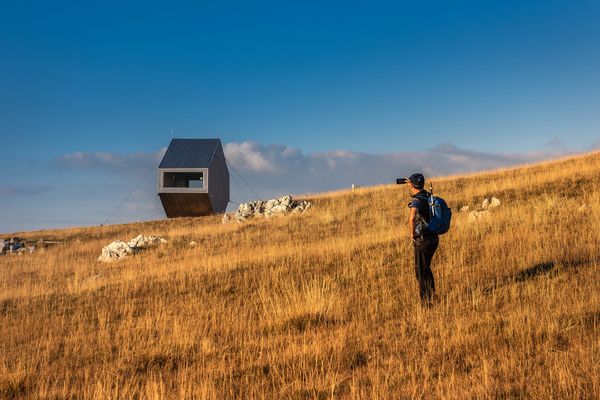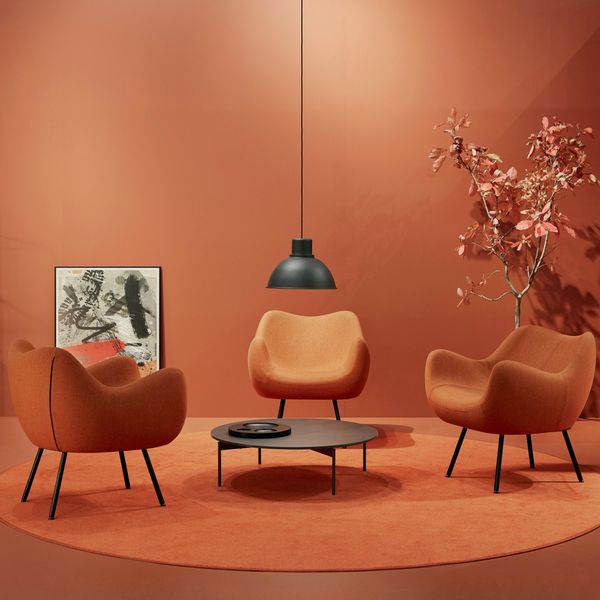So far, Dóra Zsigmond’s collections were mainly known for their coherence and finely elaborated concept design, and by now, sustainability also became one of the most important values of the brand. The use of Hungarian folklore traditions, the elements of fire and earth, and a connection to country life form an integral part of her clothes. Building on the mythical world of folklore traditions, the spring-summer RITUAL collection offers an insight into traditions of rituals, inspired by old practices of Midsummer Night celebrations. Interview!
Supernatural powers are at work, people light bonfires and jump over them in the promise of purification. They are the children of the fire. Smoky, mystical, raw atmosphere combined with a charmingly colorful and melancholic world, manifesting in the special plant-dyed, more than 60 years-old hand-woven canvasses.
The vivid rusty and yellow tones appearing on the jacquard fabrics and the floral motifs show the experimental mood of the designer, at the same time, they also reflect on the importance of flowers used during Midsummer Night rituals. While the ramie and double gauze fabrics soften the collection, the poison and olive shades on the waxed cotton and tapestry textures bring back the rawness of the country – this two-fold energy characterizes the latest ZSIGMOND DORA menswear pieces.

Tell us a little about RITAL, how is it related to previous collections and how is it different from them?
The choice of topic of the spring/summer 2020 collection is also related to Hungarian peasant culture, the collection draws on the traditions of Midsummer Night celebrations. The longest day and the shortest night, the start of astronomical summer – a real peculiarity in terms of ancient traditions. Continuing the concept and aesthetics of previous collections, it’s still indispensable for the topic to be sufficiently rich and strong, but it’s becoming more and more important that it can be interpreted on a global scale, too. The collection is inspired by the cleansing power of fire-jumping, earthy tones, rusty, fiery shades, yellows and greens. Our main character, THE CHILD OF FIRE appears on the campaign photos, being in the center of the mystical event. He is the symbol of rebirth, thinking clearly, strong and sensitive, at the same time full of curiosity and with a mission to change the mindset of today’s society.
It’s very exciting how the menswear trends mix with a respect for traditions in the collections, you also design in a higher quality, and all this in an eco-conscious manner. How do you see this development and how do you measure its success?
Sustainability has been a core value for the brand since the very beginning. In these collections, we used organic cotton, organic linen materials and PE fabrics recycled from PET bottles. The REMADE pieces are recurring elements of the brand. These are made from old, more than 60-years-old hand-woven canvasses, in collaboration with Botanika dyeing studio. Every piece is characteristic and unrepeatable. Respecting traditions, a quality-oriented approach, eco-consciousness, development and a unique tone are of primary importance for us. Updating and processing these values is our continuous task.
Bearing sustainability in mind, what production processes proved to be successful in creating your special pieces, and how accessible are these in Hungary?
Eco-consciousness as a basic approach and an indispensable element of development and sustainability has played a key role since the launch of the brand. Our products are produced in Hungary exclusively, based on orders in the majority of the cases, thus avoiding piling up an unnecessary stock. We purchase the fabrics mentioned before from European manufacturers working transparently, and in hold of the necessary professional qualifications. It’s important to note that a part of the collections is made of the „deadstock”materials of luxury brands, thus the brand avoids the environmental pollution going hand in hand with manufacturing fabrics, and utilizes the ones already manufactured in a value-creating manner. Owing to technological innovations, more and more manufacturers are experimenting with recycling, and we also work with fabrics of the kind: they create textiles out of PET bottles collected from the ocean or re-processed PE materials. We are always looking for new opportunities, and we are in close contact with manufacturers, so the latest developments are also available to us.
What types of traditional crafts techniques do you use, and how do you find them?
We incorporate one or more crafts techniques in every season. Embroidery, latch hooking and knitting are more frequently used in the winter collections, and plant-dyeing is used in the summer one. An element of the current line that is important for me is the REMADE capsule collection made out of old tapestries; the coats, trousers and sweaters are all unique pieces. My personal connection to the country does not only manifest in using crafts techniques, but also in incorporating elements of this kind. The past continues to live in the present, we carry it to the future – this is my solution to preserve traditions worthily, representing sustainability.
Tell us a bit about the days spent in quarantine. How do you seize the opportunities, what are your plans for the post-epidemic period?
The current epidemic has a significant influence on the operation of the brand, primarily as our store is closed, although the online store is still operating. The cancellation of foreign fashion events is sad, while moving them to digital platforms is progressive. Everyone has a hard time with social distancing, but we hope we won’t pick up where we left off.We share the views of internationally recognized trend forecaster Li Edelkoort, hoping for a better system and that the fashion industry is ready for the change. The epidemic brought the quarantine of consumer society, and the society gets another chance for discovering true values.

The entire collection is available in the online store.
Design & Styling: Dóra Zsigmond
Photo: Péter Lestár
Hair, campaign: Norbi Kozma
Hair, lookbook: Krisztián Hevesi
MUA: Miklós Kispál
Model: Levente, WAM Model Management

FILTER Architecture | Bivouac for hikers

VZOR | Past perfect










